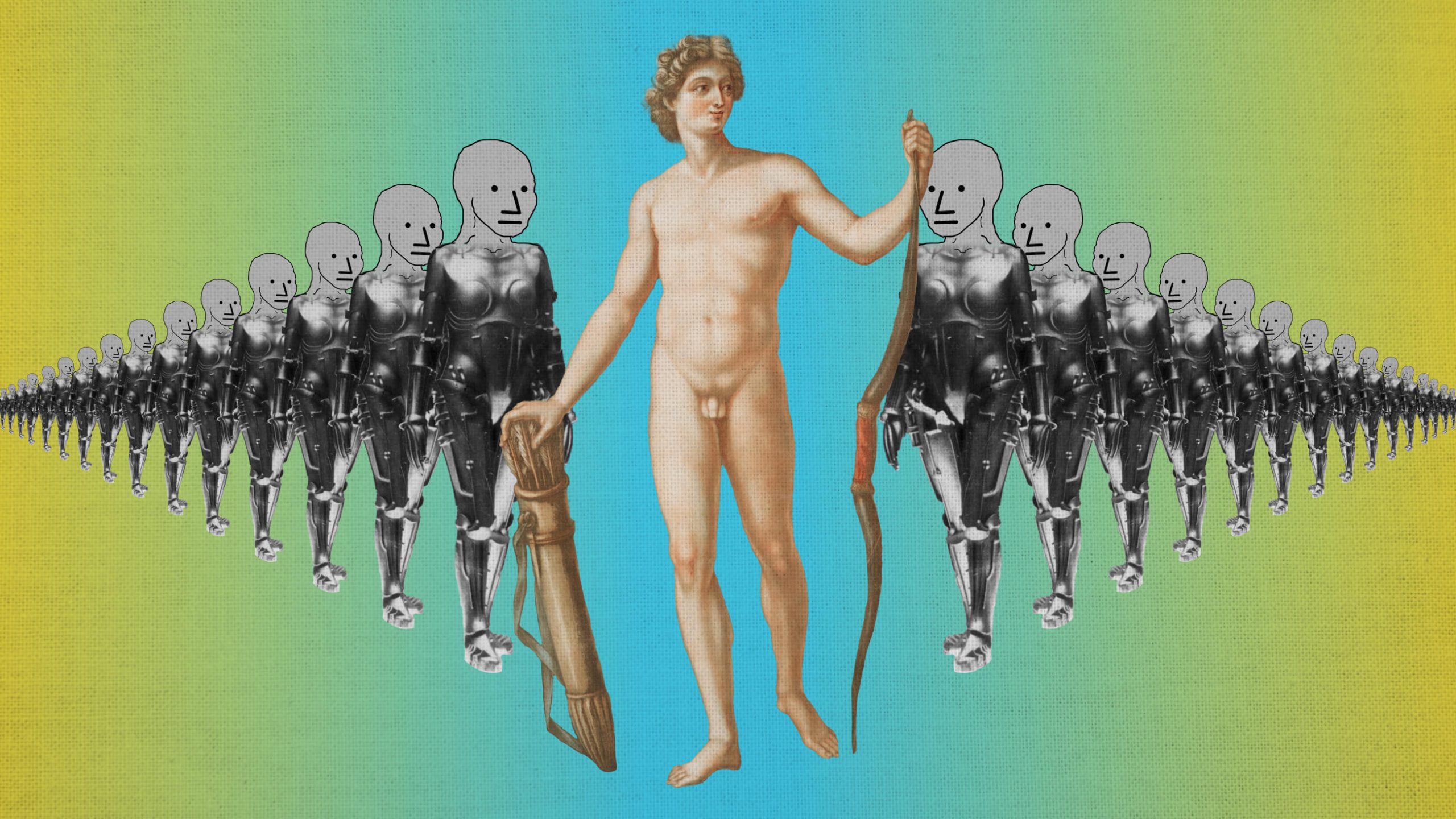Higher education has become spiritually expensive.
Sacred Culture versus Social Credit

Retrieving our sacral humanity is the only defense against the cyborg vivarium.
This article is adapted from remarks delivered this month at the Zephyr Institute.
What I call the Cyborg Vivarium—let’s say CYVI, for short—is a new, digital form of governance poised to replace the American regime. It reflects an effort to subsume all politics, and indeed all human activity, into a globally controlled, centrally managed digital system. But the digital medium itself is partly responsible too: the all-pervading technology rules our world in a way no person or persons can do anymore, independently shaping our senses and sensibilities in a direction that makes CYVI feel appropriate and makes our constitutionally guaranteed republican form of government feel obsolete. Already, there’s little question that the state-within-a-state of the military-intelligence bureaucracy has had serious success over a period of decades in designing and deploying a sort of CYVI prototype. From the secret nationwide effort requisitioning America’s industrial and intellectual resources for the Manhattan project to John von Neumann’s hydrogen bomb computer, from the quiet fusion of US and UK intelligence to the coordination of unequal speech protection and assembly online, the federal government has already so captured digital innovation that the entrepreneurial vision of “startups in a garage” now sounds laughably naive. Even Netscape was free because it was built in a federal lab. Everything from cable TV to the smartphone relies on spun-off military-intelligence research and technology.
CYVI: A History
Across details like these there’s a whole history we need to teach and learn about the development of CYVI. For those in charge, the problem with the first-generation surveillance state coming out of 9/11—infamously described in the Bush years as “Total Information Awareness”—is that it was fiercely opposed by the American Left. It was relatively easy to onboard the Right, especially the most powerful and wealthy constituencies. Ironically those most committed to the status quo were most easily persuaded to accept revolutionary change as a fait accompli—in the name of preserving the regime!
The difficulty was that this crucial gain in support was radically limited by the uniqueness of the American Right, as compared with rightist movements and identities globally. The American model of total surveillance was insufficiently scalable: a globalizing new technology, being used to globalize away the distinction between foreign and domestic control systems, as well as that between war and peace, needed a colorably “universal” basis for justification. The Cold War, which Steve Sailer has accurately described as a war for control of the global left, looked like it had reached some kind of resolution in 1991, but in 2001 the Global War on Terror threw the matter into radical doubt again. The need was to mollify and even appeal to the domestic Left with the new technological system in order to leverage global support, something the support of the domestic Right was too idiosyncratic—and too liberal—to leverage.
I’ll call this pre-smartphone system of digitizing governance CYVI 0. It was not exactly a vivarium built to design our lives in a contained and enclosed way, and that’s because we had not been sufficiently integrated into digital technology in order for a digital system to organize and manage us in that way. We were not yet cyborg enough for our regime to become an artificial habitat, with everything that would demand and imply.
That began to change when the iPhone debuted in January 2007 and the smartphone was commodified shortly thereafter. The new kind of person that then came into being—call him Smartphone Person—was swiftly cyborg enough for the construction of a digital vivarium, and that’s what began to happen.
Certainly, some of this was natural, because digital tech began in earnest to formatively reshaping our inner and outer lives. But CYVI 1 was also shaped by deliberate policy. It emerged under Obama as a kind of horse trade: Yes, you will live in a military-intelligence surveillance state. But in exchange, the White House will glow up in rainbow colors and your sense of identity and agency will be expanded. Contracting field of play in one area will be offset in another, one that more people were becoming obsessed with.
But the Obama bargain was actually conducted in secret, one Edward Snowden ruined by exposing: back to square one. Almost. The place on the Left where CYVI 1 maintained its greatest support post-Snowden was Big Tech, which was created, as we know it today, by a second Obama bargain: major tech corporations will escape the reach and oversight of antitrust in exchange for reintegration into the now-firmly globalized Five Eyes military-intelligence state. The grand messages seducing the domestic and global left—big data will save politics, save democracy, save the world etc.—hinged on the vast onboarding migration of people, industries, and institutions into a sprawling yet highly consolidated social media system.
This arrangement was actually very unstable, and its master’s shocking inability to predict the real-world consequences of behavior on social media was the painful lesson of election night 2016. Although the Left, true to plan, was totally coopted—recall the elimination of Bernie Sanders’s populist movement in subservience to more “establishment” operators. But now, the restive tribes of deplorables had exploited CYVI 1 to produce results hostile to the system—beginning with but hardly limited to Trump—and to the military-intelligence state behind it.
This was a problem for immediate reasons: it pulled the Right away from its reflexive support for CYVI. But more deeply and alarmingly, the surprise of a powerful digital Right gave the Left a new reason to reject or even reverse the advancement of CYVI. And this is what we started seeing in the explosion of wokeness: a collective conclusion that because there was no mathematical way to ensure digital entities produced ideologically correct outcomes, an ethical (really, theological) means of doing so was required. This would come in the form of anti-racism officials, A.I. ethicists, DEI and CRT educators, and Human Resources managers, all elevated to the ultimate power level where both people and bots had to be catechized into a new creed extreme enough not to be disenchanted or sidelined by the unbridled power of digital technology itself.
This was a big counteroffer in what had become a high-stakes negotiation over the terms of refounding America on a footing for the digital age. The regime still needed very much to continue globalizing the only possible way, by consolidating control over the global Left—it had to hurry up in fact because it had now created a competitor in China—and so of course it had to accept the counteroffer and take the deal. This is exactly what has happened. As the strategic network of CYVI 0 begat the social network of CYVI 1, social media begat social credit in the new model we see already today: CYVI 2.
Human Theology, Theological Humans
I don’t think I need to belabor the explanation of how the woke social credit system of CYVI 2 is incompatible with, and hostile to, even our now perhaps vestigial constitutionally guaranteed republican form of government. In a sense if you do not see how this is so fancy words and big brain arguments will not convince you.
So the question we face is whether we stop this process. The first hurdle to stopping it is the tech idea that humanity sucks, and the only part of us that really has any intrinsic or ultimate worth is the so-called spark of our consciousness. But even that “spark” is not sacred or holy because it just is, it happened, it is a mathematical fact—fun, exciting, meaningful, but no more sacred than a game you have to keep changing up to stop from being bored and meaningless.
I wrote Human, Forever to model the embodiment of our holding sacred our given human identity and body and soul, and to illustrate how CYVI 2 social credit is at odds with not only our sacred human identity but our preservation of the human way of life through the theological and socioeconomic activity of sacred or sacral culture. In this case, importantly, the medium is the message: the book is published on chain and can be bought with bitcoin—because bitcoin is more than a way to try surviving the digital transformation by imitating bots through amassing numbers and making them “go up.” It is a computational protocol that can uniquely help us fight those who, through the technological desacralization of our human body, our human soul, and our human identity, are refounding our regime as an enclosed and inescapable cyborg vivarium.
What if our opponents succeed in installing a vision of the sacred that rejects our humanity and instead worships the swarm and the cyborg vivarium? What would this powerful religion’s claims on us be? What are we willing and able to do to stop that, and what might happen to us if we don’t? Digital entities are already achieving powers of omnipresence and silent influence over us that were once thought to be province of angels and demons. Our tastemakers and politicians are haunted by visions of a tech-induced end of human spacetime, already coming into being with the zero-latency, infinitely interoperable networks promised by 5G. They dream of throwing open of not just book of life but inner secrets of all—Biblically, the province only of God the Father, at a time only of His choosing. Personally, I am reminded of the remarkable affirmation at the close of the Eastern Orthodox creed: “I look for the resurrection of the dead and the life of the age to come.” Bodily resurrection! For many, this likely sounds crazy. Yet it captures a profound understanding that, even in the end times, even after the end of our spacetime, we will and must remain as we are and as we were created—not as divine hive minds or as digital swarms, but as humans. Even in the extremity and scandal of this ultimate vision of our eternal humanity, it is radically less “crazy” than the spiritual wager of cyborg theocracy.
Whatever your religion, there is no escape from such a theological reckoning over how to reground America on a footing that will enable us to protect and enjoy the human way of life in the digital age. To rescue our politics and our humanity in the digital age, our philosophers and theorists must begin from the intuition that, even on our digitally swarmed-over planet, our given nature as human beings must, and can, endure.
The American Mind presents a range of perspectives. Views are writers’ own and do not necessarily represent those of The Claremont Institute.
The American Mind is a publication of the Claremont Institute, a non-profit 501(c)(3) organization, dedicated to restoring the principles of the American Founding to their rightful, preeminent authority in our national life. Interested in supporting our work? Gifts to the Claremont Institute are tax-deductible.
Our humanity must reassert itself over our technological power.



